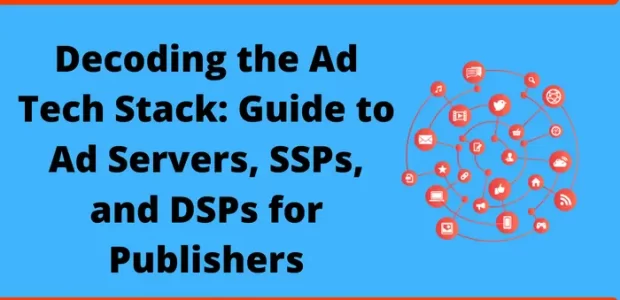
Over the years, technical advancements have mostly fueled massive shifts in the digital advertising space. Effective and efficient targeting of online audiences is made possible by decoding the ad tech stack. The enormous $886.19 billion valuation of the worldwide AdTech market in 2022 demonstrates the importance and weight of this industry. The modern digital advertising environment is broad and dynamic, as the days of private transactions between advertisers and media outlets are over.
Programmatic advertising and real-time bidding have taken the market by storm recently due to their efficiency and pinpoint targeting. The correct ads will reach their target audience at the right time, thanks to automation. Ad servers, SSPs, and DSPs, the industry’s three cornerstones, will continue to evolve subtly into 2023.
Ad Servers, the Pulse of Publishers’ Digital Ad Operations
The ad server is a crucial part of the digital advertising ecosystem. An ad server is a word that gets bandied around a lot, but you may wonder, ‘What is an ad server’ in essence? Ad servers are more than just digital storage devices since they also transmit digital ads to other channels like websites and apps. Intricate duties beyond simple distribution are taken on by ad servers.
With their help, publishers may prioritize which ads should be displayed and when. In-depth tracking capabilities and performance statistic reports are also made available to publishers.
By 2023, a select few ad servers have emerged, each with its own unique set of capabilities. Some focus on the vast territories of major publications, while others carve out a specific audience on niche websites. The goal of these systems, regardless of the demographics they target, is the same: to improve targeted ad delivery and provide publishers with more control over the monetization of their digital assets.
Ad Revenue Growth Through SSPs for Publishers
SSPs, or supply-side platforms, work in tandem with ad servers in the digital advertising industry. They automate the process by which publishers sell their digital advertising space to interested advertisers. Advertising space is auctioned off to the highest bidder in real time.
Incorporating an SSP into an ad server gives publishers more control. The ad server controls which advertisements are displayed, but the SSP makes sure they get the most money.
This synergy maximizes publishers’ ad earnings without requiring them to individually negotiate individual contracts. Now more than ever, SSPs are crucial for publishers that want to take advantage of real-time bidding and optimize their ad sales procedures to maximize their income.
Advertising and Publishing: How DSPs Connect the Two
DSPs, or demand-side platforms, are the polar opposite of SSPs. Advertisers may use these platforms to buy digital ad inventory from various publishers. Using a DSP, businesses may save time and money by automating the process of buying advertising space.
Knowledge of DSPs is essential for publishers. It reveals the needs of advertisers so that content and ad placements may be improved. When publishers adapt their methods to meet the needs of DSPs, they get better ad placements and higher earnings as a result.
Relationships Among Ad Servers, Ad Exchanges, And Ad Serving Platforms
The full potential of the ad tech stack can only be unlocked when each of its individual parts is doing what it was designed to do. Ad servers, SSPs, and DSPs all work together to facilitate a streamlined exchange of information and financial transactions.
For instance, an ad server could choose an ad from its stock to show a certain user. If the ad spot is up for grabs, the SSP will mediate a bidding war between advertisers using the DSP. The entire process of selecting the highest bidder, sending the ad, and displaying it to the viewer is completed in milliseconds. Success is ensured for the publisher, the advertiser, and the viewer by regularly switching between the three sections.
How Will the Ad Tech Stack Develop in the Years Ahead?
The digital advertising market is evolving at a breakneck pace, and with it comes constant innovation in ad technology. By 2023, privacy regulations, such as the prohibition of cookies set by third parties, will be at the forefront of policy debates. If you love to use Bing search engine, then you can get up a amazing opportunity such as Bing Ads $200 free credit in which in the first turn you’ll get $200 credit or bonus in your existing advertising account.
To maintain compliance and effectively monetize their platforms, publishers must anticipate these developments and alter their plans accordingly. Emerging technologies will have an impact on the future. How they will affect the industry as a whole is unclear, but successful publishers of the future will need to be adaptable and modern.
Conclusion
The ad tech stack provides essential support for the complex framework of the digital advertising industry. By having ad servers, supply-side platforms, and demand-side platforms work together, they improve ad delivery, audience engagement, publisher profitability, and advertiser value.
Recognizing this interplay’s subtleties and adapting to the ever-evolving digital world will be crucial. Long-term success and innovation in digital advertising require this comprehension.
